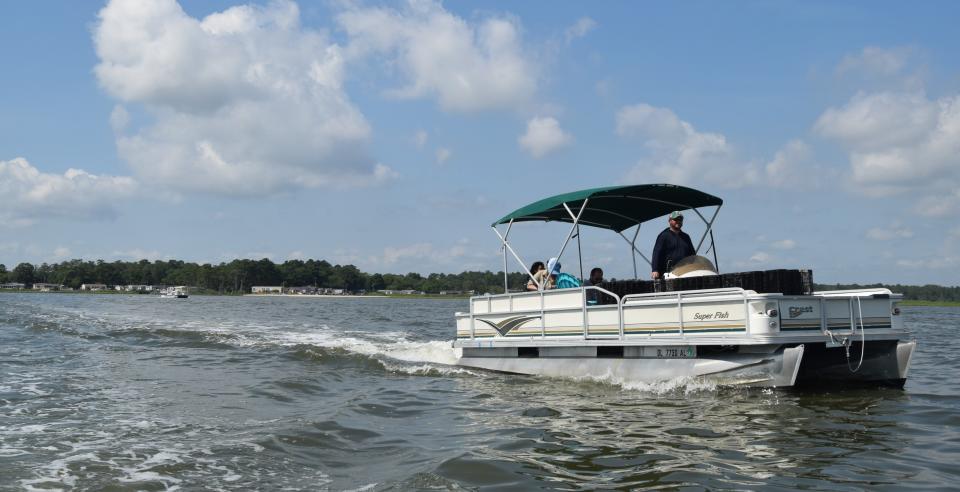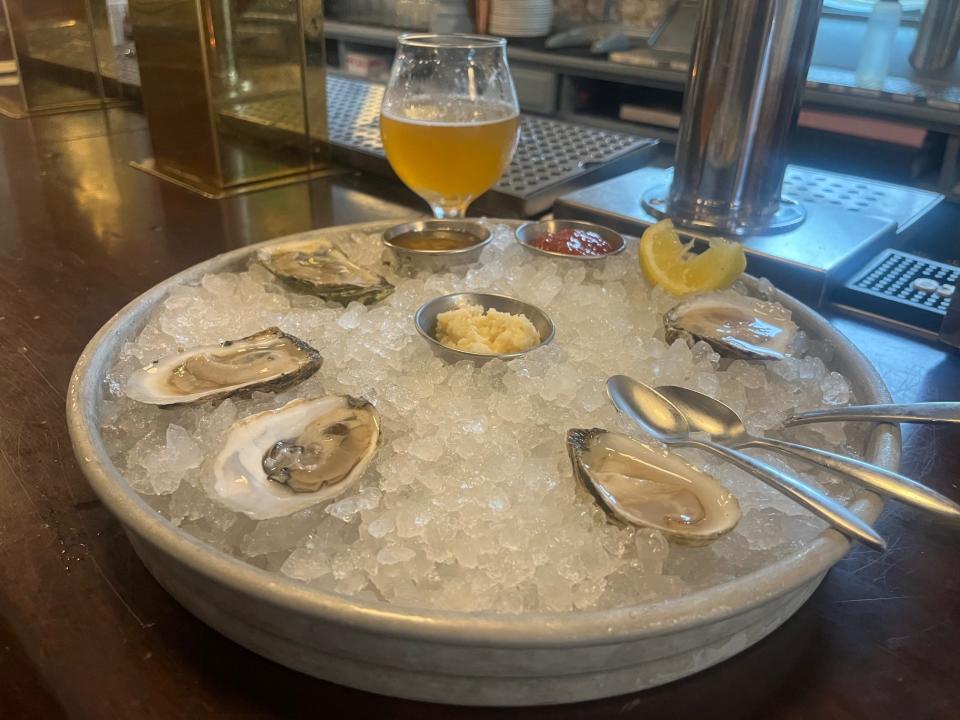First Delaware-hatched oysters in four decades are now growing in the bay
Only the trained eye would know that those 200 bags of shells contained anything special.
But inside were the seeds of a reborn Delaware industry: 105,000 baby oysters no wider than the tip of a crayon, just 2 millimeters across.
In July, for the first time in at least four decades, a Delaware hatchery delivered oyster seed to a Delaware oyster company, ready to be planted in Delaware waters. The oyster growing site is located in the Delaware Bay, just off Port Mahon.
“We were thrilled to get them out the door,” said marine studies assistant professor Ed Hale, part of the team at the public Delaware Sea Grant hatchery at the University of Delaware who worked to grow that first viable crop of oyster seed.
That batch of oysters was a success beyond their earliest hopes, Hale said. The hatchery, a partnership between aquaculture programs at UD and Delaware State University, received a grant to start operations only last year. Delaware Sea Grant didn't expect a viable crop for another two years.
It’ll still be a few more years till they're able to work up to the 50 or 75 million oysters they hope to hatch at full capacity. But a first commercially viable batch of hatchery oysters was momentous news for Delaware, he said.
It's a crucial step toward the rebirth of a crop that was once renowned all across the region and world: the Delaware oyster, one-time white gold of the bays.
“As far as I know, nobody else has done that in Delaware before,” Hale said in a release from the University of Delaware.
Oysters are back: How Delaware oysters reappeared on local menus
Delaware's new oyster industry: Watermen become pioneer farmers on the water
'Decades behind': A crisis for the once world-famous Delaware oyster
Delaware Bay oysters were once sold across the globe, so plentiful that oystermen’s white sails covered the horizon on the first cold days of the year.
When Dutch colonists first arrived at Cape Henlopen, they were greeted by mounds of shells dispersed across the shoreline: evidence of previous feasts by Native Americans. By the 19th century, all of Sussex County gathered for raucous “Big Thursday” parties to mark the first day of each year's lucrative oyster harvest.

But oyster stocks declined precipitously during the 20th century, in both the Delaware and Chesapeake Bays ― victim to overfishing, pollution and parasites. Delaware aquaculture was abandoned entirely by 1979.
Even as new disease-resistant oysters began to return in New York and Virginia and the Jersey side of the Delaware Bay, the state of Delaware kept its oyster beds empty.
A 2013 law finally allowed new commercial oyster leases in Delaware, but the process moved slowly: Delaware’s first commercial oyster leases in the Inland Bays weren’t approved until late 2017, with the first oyster harvest in the following year.
“Delaware is basically decades behind every other state,” Hale said.
This year there are just 10 commercial oyster leases in the Inland Bays, down from 13 three years ago, according to numbers kept by the Department of Natural Resources and Environmental Control, which administers leases for oyster farms.
One of the things slowing the industry down, Hale said, was that farms in Delaware had nowhere within the state to buy oyster seed. Growers were forced to compete for baby oysters from hatcheries in New Jersey or Virginia who had already forged relationships with other buyers.
This had the effect of hamstringing an incipient oyster industry struggling to build itself from the seafloor up, Hale said.
“There's decades’ worth of oyster farmers in every other state competing for their own interests,” he said. “Delaware farmers effectively are at the bottom of the list in terms of who (oyster hatcheries) are going to try and satisfy.”
A new Sea Grant hatchery is designed to supply oyster seed to farms and reefs
From the first year that the state of Delaware began to provide leases to a new generation of oyster farmers, Sea Grant scientists from UD and DSU were already at work helping plant oyster seed for commercial fisheries and environmental projects alike.
Soon it became evident that gaining access to oyster larvae was a bottleneck for the budding industry. A grant from the state of Delaware in 2022 offered funding for a potential solution: Delaware’s first public hatchery.
The process at the Delaware Sea Grant hatchery on the UD Lewes campus was improvisational at first, Hale said, moving at such a breakneck pace they barely had time to plan anything before they were already doing it.
“We were gluing plumbing joints and everything,” he said. “I'm working on this thing at six o'clock in the morning, and then going in to my day job. … We moved to production about two years quicker than when we thought we would. We had no, no idea what we were doing.”
Six of the early oyster broods were lost to high water temperatures, or perhaps “something unknown in the water” as they worked out filtration systems for Delaware waters previously untried for growing hatching oysters.
“There's all these things that we have to learn how to effectively maintain and manage because we didn't ever draw on water from this location before,” Hale said.
But they also found unexpected success: They were able to grow two viable broods and plant them in shells.
Hale credits this early triumph to hatchery coordinator Alyssa Campbell, who arrived with experience working in hatcheries across the West Coast and in Cape May.
“I attribute a large part of our success both to a little bit of luck, but also to her expertise,” Hale said. “I really have to give credit where it’s due.”

'Absolutely monumental': The first new born-and-raised Delaware oysters are within reach
Scientists at Sea Grant hope that this first commercially sold batch from a Delaware hatchery, and others in the future, can help support a growing Delaware oyster industry.
The Sea Grant program is designed in part to help ecological remediation in Delaware's bays: Oysters are remarkably efficient filters, helping clean the waters of the bays as oysters draw nutrients.
Delaware Sea Grant's team hopes that oysters hatched in Delaware waters will thrive better, and be better attuned to local conditions in the Delaware Bay or the Inland Bays. Using oysters grown in Delaware will also simplify the regulatory hassles involved in bringing out-of-state oysters to Delaware waters, Hale said.
But the moment Hale really looks forward to is the day he can order oysters his team grew at a local restaurant ― or one farther afield.
This year, Delaware oysters are on the menu at a few restaurants in Coastal Delaware, at the Lewes and Henlopen City oyster houses, or at Dogfish Head's Chesapeake and Maine.
But for now, Delaware oysters are in short supply. Around 400,000 oysters were sold by Delaware oyster farms in 2021, the most recent numbers from DNREC. Even as Jersey oysters like Sweet Amalia garner national attention, oysters from the Delaware side of the bay quickly grow scarce by the time you leave Sussex County.
That's something Delaware Sea Grant hopes to help change.
“The day where we can actually sit down at a restaurant and say, ‘We produced this two years ago and somebody took it out and here we are eating it'? That’s absolutely monumental,” Hale said. “It's a big deal.”
Matthew Korfhage is a USA Today Network reporter in the broader Philadelphia region, covering culture, food, equity, science and why the trains don't run on time. Email him at mkorfhage@gannett.com or follow him on the site formerly known as Twitter @matthewkorfhage.
This article originally appeared on Cherry Hill Courier-Post: First Delaware-hatched oysters in four decades are now growing

